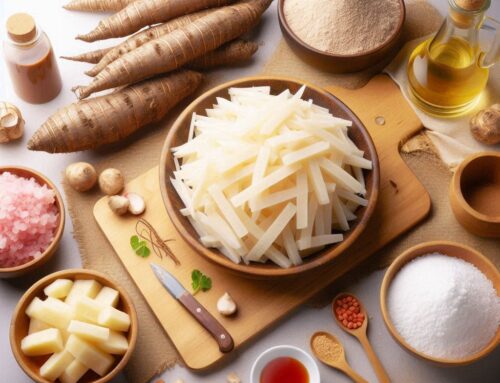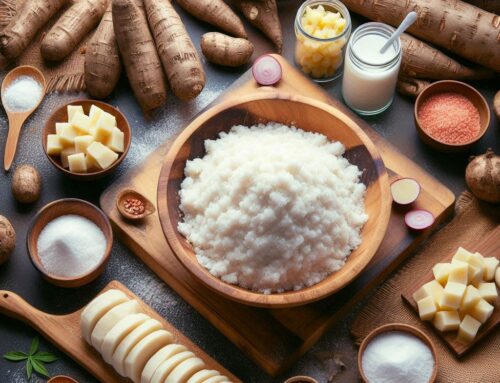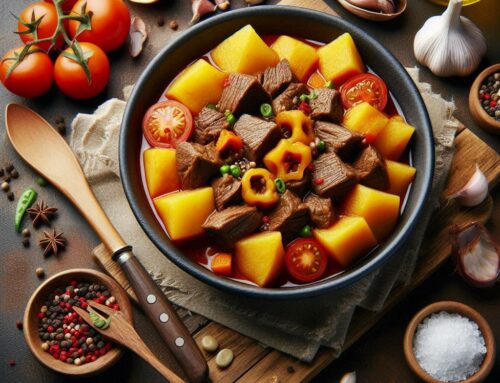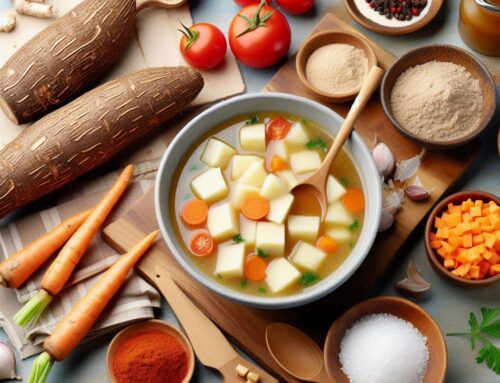
Introduction: Understanding Cassava and Its Nutritional Benefits
Cassava, also known as yuca or manioc, is a starchy root vegetable that is a staple food for millions of people worldwide, particularly in Africa, Asia, and Latin America. This versatile root is not only valued for its culinary uses but also for its significant nutritional profile. Understanding cassava and its nutritional benefits can help integrate this important crop into a balanced diet.
Cassava nutrition primarily consists of carbohydrates, making it an excellent energy source. It contains small amounts of protein and fat while being rich in essential vitamins and minerals such as vitamin C, thiamine (vitamin B1), riboflavin (vitamin B2), and niacin (vitamin B3). Additionally, cassava provides dietary fiber that aids in digestion.
The health benefits of cassava extend beyond its macronutrient content. It is naturally gluten-free, making it an ideal substitute for wheat-based products for those with gluten sensitivities or celiac disease. Furthermore, the antioxidants present in cassava can contribute to overall health by combating oxidative stress within the body.
Despite these benefits, it’s important to note that raw cassava contains cyanogenic glycosides that can be toxic if consumed improperly. Proper preparation methods such as soaking, boiling, or fermenting are essential to ensure safety when consuming this root vegetable.
Incorporating cassava root into your diet can offer numerous health advantages while adding variety to your meals. Whether used in traditional dishes or modern recipes like gluten-free baking flour alternatives or tapioca pearls for desserts, understanding the nutritional value of cassava helps maximize its potential benefits.
The Importance of Cooking Cassava Correctly: Safety First!
Cassava, a staple food for millions around the world, is celebrated for its versatility and nutritional value. However, ensuring cassava safety is paramount due to the presence of toxic compounds in its raw form. Cassava contains naturally occurring cyanogenic glycosides, which can release cyanide when not processed correctly. Consuming improperly prepared cassava can lead to serious health risks, including acute intoxication and chronic conditions.
Understanding how to detoxify cassava is crucial for safe consumption. The most effective methods involve peeling the roots thoroughly and soaking them in water for several hours before cooking. This process helps leach out the harmful compounds. Additionally, fermenting cassava or drying it under sunlight are traditional techniques that further reduce toxicity.
Safe cooking methods for cassava include boiling or steaming until fully cooked, as high temperatures help break down any remaining toxins. Frying should be approached with caution unless preceded by adequate soaking and boiling steps. By following these guidelines, you can enjoy this versatile root vegetable safely while reaping its nutritional benefits without compromising health.
Step-by-Step Guide to Preparing Cassava for Cooking
Cassava, also known as yuca, is a versatile root vegetable that can be transformed into a variety of delicious dishes. Preparing cassava for cooking involves several important steps to ensure it is safe and ready to eat. Here’s a step-by-step guide to help you navigate this process.
1. Peeling Cassava: Begin by thoroughly washing the cassava roots under running water to remove any dirt or debris. Using a sharp knife, carefully cut off both ends of the root. The skin of cassava is thick and waxy, so it’s best to make a shallow cut lengthwise along the surface and then use your fingers or the knife to peel away the skin in strips.
2. Soaking Cassava Roots: Once peeled, cut the cassava into manageable pieces. It’s crucial to soak these pieces in cold water for at least an hour before cooking. This step helps reduce cyanogenic compounds naturally present in raw cassava that can be harmful if ingested in large amounts.
3. Boiling Cassava Safely: After soaking, drain and rinse the cassava pieces thoroughly with fresh water. Place them in a pot filled with enough water to cover them completely and bring it to a boil over medium heat. Allow the cassava to cook until it becomes tender; this usually takes about 20-30 minutes depending on the size of your pieces.
By following these steps—peeling, soaking, and boiling—you can prepare yuca root safely for your next culinary creation while ensuring its natural flavors are preserved for enjoyment in various recipes.
Popular Techniques for Cooking Cassava: From Boiling to Baking
Cassava, also known as yuca, is a versatile root vegetable that can be prepared in a variety of delicious ways. Understanding the popular techniques for cooking cassava can help you make the most of this starchy staple.
One of the simplest methods is boiling. A classic boiled yuca recipe involves peeling and cutting the cassava roots into chunks, then simmering them in salted water until tender. This method brings out the natural flavors and provides a soft texture that’s perfect as a side dish or mashed alternative to potatoes.
For those who enjoy crispy snacks, frying techniques for yuca chips are a must-try. Thinly slice the cassava roots and fry them in hot oil until golden brown. The result is a crunchy treat that pairs well with dips or stands alone as an addictive snack.
Baking cassava roots offers another healthy option. After peeling and slicing, toss the pieces with olive oil and your choice of seasonings before spreading them on a baking sheet. Bake until they are crisp on the outside yet tender inside—a delightful accompaniment to any meal.
Steaming yuca roots is another gentle cooking technique that preserves nutrients while creating a soft texture. Simply peel, chop, and place them in a steamer basket over boiling water until they reach your desired tenderness.
Each method highlights different aspects of cassava’s unique flavor profile, offering diverse options for incorporating this nutritious root into your culinary repertoire.
Mouth-Watering Recipes Featuring Cooked Cassava
Cassava, also known as yuca, is a versatile root vegetable that has found its way into kitchens around the world. Whether you’re looking for a comforting dessert or a savory side dish, cooked cassava can be transformed into delicious recipes that will leave your taste buds craving more.
One popular dish is the **cassava pudding recipe**, which combines grated cassava with coconut milk, sugar, and spices to create a rich and creamy dessert. This pudding is often baked until golden brown and can be served warm or chilled. It’s perfect for those who enjoy sweet treats with a tropical twist.
For those who prefer something savory with a bit of heat, the **spicy fried yuca sticks recipe** is an excellent choice. Start by boiling yuca until tender, then cut it into sticks and fry them until crispy. Toss these golden delights in a mixture of chili powder and lime juice for an irresistible snack that’s crunchy on the outside and soft on the inside.
Finally, there’s nothing quite like **traditional boiled yuca with garlic sauce** to accompany your main course. Boil peeled yuca roots until they’re fork-tender and serve them drizzled with a garlicky olive oil sauce infused with fresh herbs. This simple yet flavorful dish highlights the natural taste of cassava while adding depth to any meal.
These mouth-watering recipes showcase just how diverse cooked cassava can be in culinary creations. Whether you’re indulging in sweet or spicy flavors, there’s no doubt that this humble root vegetable will become a staple in your cooking repertoire.
Cultural Significance of Cassava in Global Cuisines
Cassava, known by various names such as yucca and manioc, holds a prominent place in global cuisines, particularly in African, South American, and Caribbean culinary traditions. In African cuisine, cassava is often transformed into a staple food product called fufu. This starchy accompaniment is typically served alongside rich stews and soups, providing a hearty base that complements the vibrant flavors of the region’s dishes. The versatility of cassava allows it to be used in both savory and sweet preparations across the continent.
In South America, the root takes on new life as yucca in an array of traditional recipes. It is frequently boiled or fried to accompany meats or incorporated into stews like Sancocho—a beloved dish that varies from country to country but consistently relies on the comforting texture of yucca root. Additionally, yucca flour is a key ingredient for making pão de queijo (cheese bread) in Brazil, showcasing its adaptability beyond just being consumed as a vegetable.
The Caribbean islands also celebrate cassava through their unique culinary creations. Manioc flour serves as a foundation for bammy—a type of flatbread originating from Jamaica that pairs beautifully with fried fish or jerk chicken. Moreover, cassava pone—a dense dessert made with grated manioc—is cherished for its sweet taste and chewy texture.
Across these diverse regions, cassava not only provides sustenance but also connects communities through shared cultural practices and traditional recipes passed down through generations. Its significance extends beyond mere nutrition; it symbolizes resilience and adaptation within various cultural contexts around the world.






